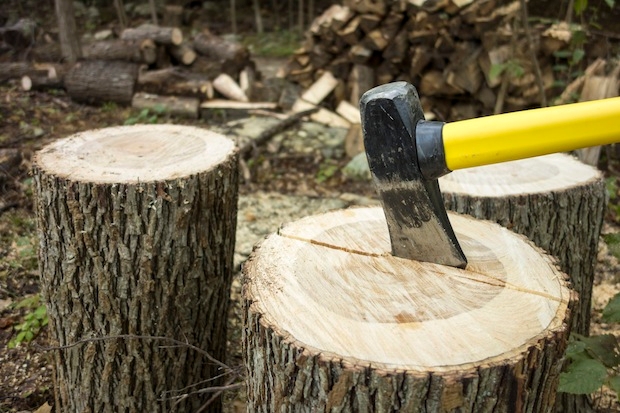Until a fortnight ago there was a healthy, graceful, 70ft-specimen of Eucalyptus dalrympleana — or mountain gum — in the garden. Now there isn’t. Or rather, the remains of the trunk and branches are lying in sections on the ground. To knock a few quid off the tree surgeon’s bill, I’d grandiosely told them not to bother reducing the trunk and major branches to fire-grate-sized logs. Leave it in rings, I said, and I’ll split them up with an axe. Which they did. The next time I looked out, the men had departed and there were a couple of tons of wood lying in wheels in the sodden grass. The biggest rings, from the base of the trunk, were about two feet in diameter and a foot thick. Not a problem. A joy. I filed a razor-sharp edge on the axe-head, put the two biggest, knottiest-looking rings one on top of the other for a chopping block, and started swinging.
Why is splitting wood so supremely satisfying? Does anybody know? The first afternoon of log-splitting didn’t feel like labour. The lovely tree bore me no ill-will and yielded generously to the blade. Knots were few and honest about their hidden extent. My pile of split wood grew quickly and looked as photogenic in the winter-afternoon sunlight as only a woodpile can.
My old axe and I became reacquainted. Accuracy was at first based on hope, then faith, then belief, then certainty. As confidence grew, the starting point of the axe-head moved further down my back so that full momentum could be achieved long before the axe-head reached the apogee of the arc. Each stroke of the axe meant a preliminary rough guess at the amount of force required to split the wood. My axe was a little too sharp. If I over-estimated the force required to split a log, the axe-head buried itself in the chopping block and was the devil to get out again. Otherwise it was the most pleasurable afternoon I’d spent since I’d last wielded an axe, which was couple of winters ago.
The next day, the grandson came to spend the afternoon. Right, I thought. Today would be that Holy day when man initiates boy into the mystical pleasures of manual labour. In all of his four years I don’t suppose he’d seen even a hole being dug with a spade except at the beach. He was serendipitously wearing a shirt of lumberjack check. I changed into one myself. And together we walked out on to the fields of praise carrying our tools. Never give a sword to a man who can’t dance, goes the old Celtic saying. Oscar can dance. (Lately he and I have been dancing deliberately and effetely to ‘Love Calls’ by Headstrong Feat.) He carried the axe proudly to the place of mud and white splinters, affecting nonchalance.
His first-ever job of manual labour was to gather up the wood that I’d split and throw it on the pile. To give him a rough idea of the exciting possibilities that lay before us, I selected the thickest ring and heaved it up on to the chopping block. Then I swung back and smashed it asunder and Oscar shrieked with joy and perhaps surprise at his grandad’s alacrity. And then we went to work: me chopping, him chucking.
I think Oscar must have been a member of the labouring classes in his previous life. Getting his hands dirty meant nothing to him. He rolled up his sleeves to his elbows like an old navvy. He was attentive, committed, unafraid. He showed initiative and team spirit. He relished the challenge of trying the limits of his strength. He did everything but spit on his hands. He’d have been just the sort of bloke a short-staffed 19th-century mill owner would have been looking for.
If he has a fault, it is to ask too many questions. He calls me Germy. He prefaces every question with it. All too often, he would time his question for that split second when the axe-head was poised at the height of its swing and grandad was on tiptoe, concentrating every fibre as he pulled the trigger. ‘Germy?’ he said, on one such occasion. I pressed the emergency stop button and stood tottering on tiptoe, the axe still at the perpendicular. ‘Yes,’ I said as kindly as I could manage. ‘Look at the moon, Germy,’ he said, pointing behind me. I peered over my shoulder at it. A brilliant half-moon in a mauve evening sky. It was extraordinarily bright. So I lowered the axe and gathered my workmate up into my arms and together we observed the moon in silence for perhaps a minute, before resuming our work again.







Comments